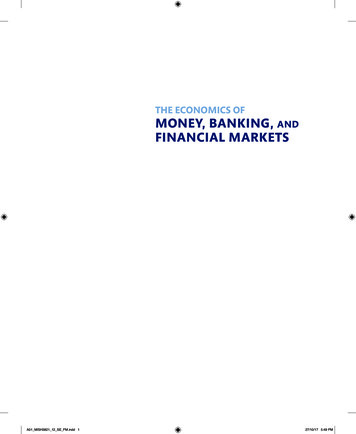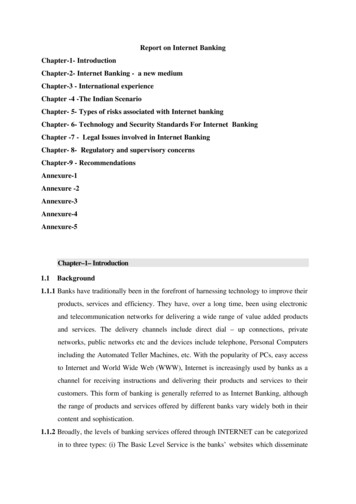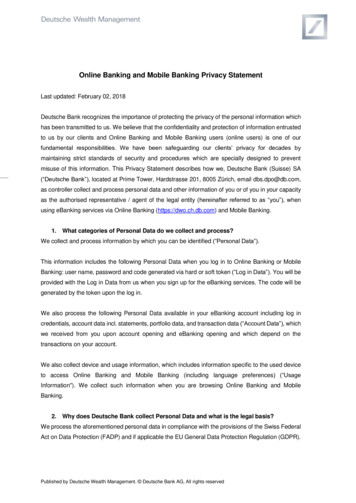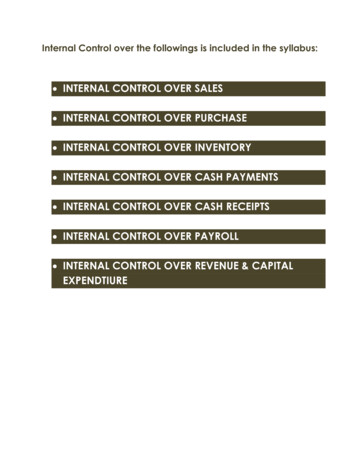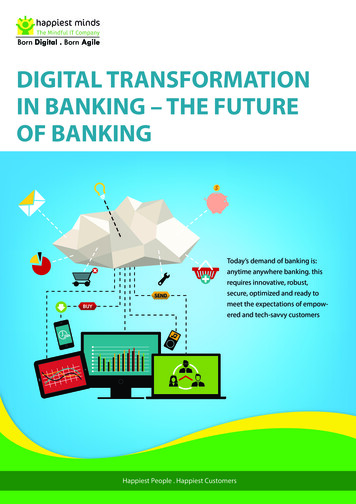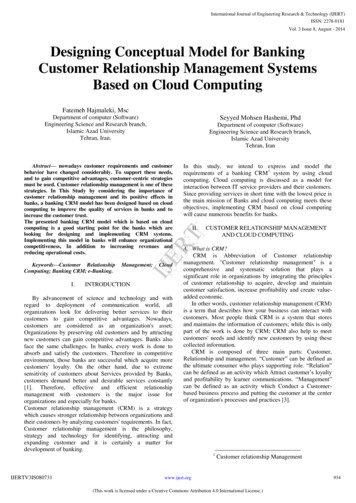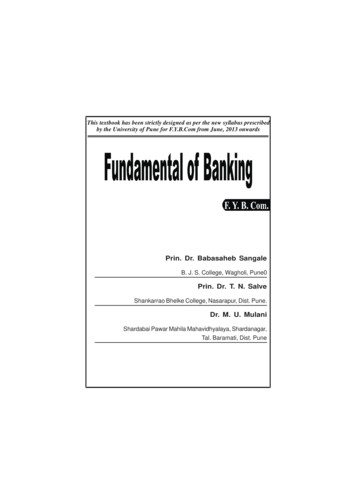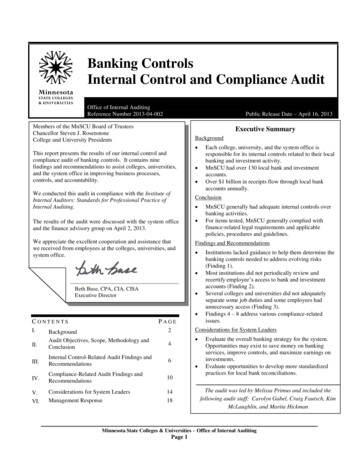
Transcription
Banking ControlsInternal Control and Compliance AuditOffice of Internal AuditingReference Number 2013-04-002Public Release Date – April 16, 2013Members of the MnSCU Board of TrusteesChancellor Steven J. RosenstoneCollege and University PresidentsExecutive SummaryBackground Each college, university, and the system office isresponsible for its internal controls related to their localbanking and investment activity.MnSCU had over 130 local bank and investmentaccounts.Over 1 billion in receipts flow through local bankaccounts annually.This report presents the results of our internal control andcompliance audit of banking controls. It contains ninefindings and recommendations to assist colleges, universities,and the system office in improving business processes,controls, and accountability. We conducted this audit in compliance with the Institute ofInternal Auditors: Standards for Professional Practice ofInternal Auditing.Conclusion MnSCU generally had adequate internal controls overbanking activities.For items tested, MnSCU generally complied withfinance-related legal requirements and applicablepolicies, procedures and guidelines.The results of the audit were discussed with the system officeand the finance advisory group on April 2, 2013. We appreciate the excellent cooperation and assistance thatwe received from employees at the colleges, universities, andsystem office.Findings and Recommendations Beth Buse, CPA, CIA, CISAExecutive Director CONTENTSI.PAGEInstitutions lacked guidance to help them determine thebanking controls needed to address evolving risks(Finding 1).Most institutions did not periodically review andrecertify employee’s access to bank and investmentaccounts (Finding 2).Several colleges and universities did not adequatelyseparate some job duties and some employees hadunnecessary access (Finding 3).Findings 4 – 8 address various compliance-relatedissues.Considerations for System Leaders2II.BackgroundAudit Objectives, Scope, Methodology andConclusionIII.Internal Control-Related Audit Findings andRecommendations6IV.Compliance-Related Audit Findings andRecommendations10V.VI.Considerations for System LeadersManagement Response1418 4 Evaluate the overall banking strategy for the system.Opportunities may exist to save money on bankingservices, improve controls, and maximize earnings oninvestments.Evaluate opportunities to develop more standardizedpractices for local bank reconciliations.The audit was led by Melissa Primus and included thefollowing audit staff: Carolyn Gabel, Craig Fautsch, KimMcLaughlin, and Marita HickmanMinnesota State Colleges & Universities – Office of Internal AuditingPage 1
April16, 2013Banking Controls Internal Control and Compliance AuditSection I: BackgroundMnSCU colleges, universities, and the system office (“institutions”) had over 130 local bank andinvestment accounts of which 74 were checking and savings accounts. Institutions maintain localbank accounts to deposit receipts from a variety of sources. Some receipts remain in them untilthey are spent or invested while others are “swept” or moved by the State of Minnesota into thestate’s bank account (state treasury). Examples of receipts swept by the State include tuition,fees, and room and board. Examples of receipts that remain in local bank accounts includeauxiliary services such as parking, food service, and bookstore receipts, as well as other receiptssuch as federal student financial aid and scholarship and endowment funds. As noted in Table 1,over 1 billion in receipts flow through local bank accounts each year. In addition, over 770million in student loan activity flows through the local bank accounts.Table 1: Tuition, Fees, and Sales, Net for Year Ended June 30(In Thousands)Carrying Amount201220112010Tuition 853,040 832,637 784,601Fees89,72495,05292,521Sales and room and board133,301135,871137,771Restricted student payments109,698106,308100,226Totals 1,185,7631,169,868 1,115,119Source: Minnesota State Colleges and Universities Annual Financial Report for the Years ended June 30, 2012and June 30, 2011 (Note 12 – Gross).As noted in Table 2, the system had approximately 114 million in cash and cash equivalents inlocal bank accounts and approximately 793 million in the state treasury at June 30, 2012.Table 2: Cash and Cash Equivalents for Year Ended June 30(In Thousands)Carrying Amount201220112010Cash, in bank 56,362 60,809 46,487Money markets8,8325,5734,508Repurchase agreements17,31713,5017,736Restricted local cash454434414Cash, trustee account (US Bank)31,24286,25547,705Total local cash and cash equivalents 114,207 166,572 106,850Total treasury cash accounts793,130754,154658,524Grand Total 907,337 920,726 765,374Source: Minnesota State Colleges and Universities Annual Financial Report for the Years ended June 30, 2012and June 30, 2011 (Note 2).Institutions are allowed to invest local funds. Minnesota statutes allow institutions to invest fundsin depository type accounts or in longer term investments, limited to government bonds, notes,bills, and mortgage backed securities, excluding high risk mortgage backed securities. The valueof these investments at June 30, 2012, exceeded 26 million.Minnesota State Colleges & Universities – Office of Internal AuditingPage 2
April 16, 2013Banking Controls Internal Control and Compliance AuditOnline banking has grown over the past several years and is used by every MnSCU institution.Institutions use it for a variety of reasons including accessing critical information and initiatingACH payments and wire transfers. While online banking provides convenience, it also introducesrisks that need to be addressed.Each college, university, and the system office is responsible for managing its own controlsrelated to their local banking and investment activity. Examples of key controls include: Reconciling bank accounts to MnSCU’s accounting system.Reconciling MnSCU’s accounting system to the State of Minnesota’s accounting system.Collateralizing bank accounts.Positive Pay: Transmitting payment information to the bank so it can match the checks aninstitution issues with those presented to the bank for payment. Any check considered to bepotentially fraudulent is flagged for the institution to examine.Limiting employee access to local bank accounts and banking transactions based on jobresponsibilities and business need.Separating duties so no one individual can control a process from start to finish.Dual controls such as requiring more than one individual to approve riskier transactions suchas wire transfers.Minnesota State Colleges & Universities – Office of Internal AuditingPage 3
April16, 2013Banking Controls Internal Control and Compliance AuditSection II: Audit Objectives, Scope, Methodology, and ConclusionObjectivesThe objectives for this audit were to answer the following questions: Did colleges, universities, and the system office internal controls provide reasonableassurance that bank financial activities were adequately safeguarded, accurately recorded inthe accounting records and complied with finance-related legal requirements? For the items tested, did colleges, universities, and the system office comply with significantfinance-related legal requirements, including state laws, regulations, contracts, and applicablepolicies, procedures, and guidelines? Do opportunities exist for management to improve business processes over banking controlsto make them more efficient and effective?Scope and MethodologyOur audit scope included banking-related internal controls of the system office and MnSCU’s 31colleges and universities. The 31 colleges and universities are defined by the number ofpresidents. However, three presidents oversee nine institutions; five colleges comprise theNortheast Higher Education District, Anoka Ramsey Community College and Anoka TechnicalCollege is aligned as are Bemidji State University and Northwest Technical College. Banking ismanaged separately at each of these locations. As a result, we considered and separately surveyed37 colleges and universities as well as the Northeast Service Unit and the system office. Theareas of focus included: Bank account reconciliationsBanking contracts and investment and collateral requirementsBanking transactions such as initiating withdrawals, check payments, and electronic paymenttransactions such as ACH and wire transfersEmployees’ access and ability to initiate banking transactions via MnSCU’s accountingsystem, in person at a bank location, or onlineOther controls such as positive pay, dollar limits, and dual controls or approvalsIn addition to surveys, we reviewed relevant documentation such as MnSCU policies, procedures,and guidelines and considered risks of fraud and errors and potential noncompliance with financerelated legal requirements in designing our audit approach. We analyzed data to identify unusualtransactions or significant changes and reviewed computer system to identify transactions thatstaff could initiate, approve, or process to determine whether duties were adequately separated.Finally, we selected a sample of transactions and reviewed supporting documentation to testwhether the controls were effective and if the transactions complied with legal requirements andMnSCU policies, procedures, and guidelines.Minnesota State Colleges & Universities – Office of Internal AuditingPage 4
April 16, 2013Banking Controls Internal Control and Compliance AuditOverall ConclusionColleges, universities, and the system office generally had adequate internal controls to providereasonable assurance that banking activities were adequately safeguarded, accurately recorded inthe accounting records, and complied with finance-related legal requirements. For items tested,colleges, universities, and the system office generally complied with significant finance-relatedlegal requirements, including state laws, regulations, contracts, and applicable MnSCU policies,procedures, and guidelines.We did, however, identify several internal control deficiencies that are discussed in Section III:Internal Control-Related Audit Findings and Recommendations. We also noted a few examplesof noncompliance that are discussed in Section IV: Compliance-Related Audit Findings andRecommendations.Finally, in Section V, we discuss two topics for system leaders to consider for future changes andcontinuous improvement.Minnesota State Colleges & Universities – Office of Internal AuditingPage 5
April16, 2013Banking Controls Internal Control and Compliance AuditSection III – Internal Control-Related Audit Findings and Recommendations1. Institutions lacked guidance to help them determine the appropriate banking controlsneeded to adequately address evolving risks, particularly as technology continues tochange.MnSCU lacked policies, procedures, guidelines, or other guidance to help institutions identifybanking related risks and appropriate internal controls to mitigate them. Some fundamentaldetective controls, such as bank account reconciliations, were a common practice performedmonthly by each institution. However, other key controls, including those addressing risksassociated with technology and online banking, varied greatly between institutions. Thesevariances were not due to institution size or location.Positive Pay20 institutions did not use positive pay. Positive Pay1 is a service offered by many bankswhere the bank matches the checks an organization issued with those presented to the bank forpayment. The check issuer must provide the bank with an electronic file containing the checkdata needed for verification. Any check considered to be potentially fraudulent is not paiduntil it is reviewed and determined correct by the issuer.Wire TransfersElectronic wire transfers could be initiated online, in-person, or via a telephone call. Manyinstitutions did not establish restrictions such as maximum dollar amounts allowed, who couldreceive wire transfer, or where funds could be transferred (e.g. international). Also, many didnot require a second person to approve the transaction. In some cases, there were norestrictions or second approval required. A few had a restriction on the maximum dollaramount allowed but the limits were very high. One institution allowed wire transfers to beinitiated online up to 15 million and did not require a second person to approve them. Wiretransfers are a particularly risky transaction because the funds can be transferred almostimmediately to anywhere in the world.Online BankingOnline banking allows for convenience and speed; however, these benefits also make onlinebanking very risky if additional controls are not implemented. Some online banking systems only required one form of authentication, a user account andpassword. Security best practices recommend a second form of authentication to also beused. The second form is often something the person has in their possession such as anauthentication token or smart card.We identified four institutions that allowed employees to share logon accounts andpasswords resulting in loss of accountability.Many employees accessed online banking systems using the same computer they used forall other job duties, including browsing web pages on the Internet and reading emails.These are common avenues criminals use to gain unauthorized access to banking1An alternative to positive pay is reverse positive-pay. In this scenario, the issuer must self-monitor and alert thebank when it declines a check.Minnesota State Colleges & Universities – Office of Internal AuditingPage 6
April 16, 2013 Banking Controls Internal Control and Compliance Auditaccounts. For example, unauthorized software may be installed by simply visiting awebsite or opening an email attachment. The software captures all key strokes, includingaccount names and passwords, and sends the information to the criminals. Security bestpractices recommend highly secured single purpose computers or other alternatives beused for accessing online banking systems.A few institutions indicated they allowed employees to access online banking systemsusing mobile devices such as smartphones and tablet computers. Security best practicesrecommend highly secured devices or other alternatives be used for accessing onlinebanking systems.Direct DepositMany institutions use the MnSCU accounting system to produce an electronic direct depositor “ACH” file that is subsequently transmitted to the bank to process Automated ClearingHouse or ACH transactions. 20 institutions use this method to pay student workers or todisburse financial aid overages to students.Most institutions had employees use their computer to produce and store the ACH file beforetransmitting it to the bank. Practices varied where the ACH files were stored. Someemployee’s stored the file on the computer used to generate the file; other’s stored them onremovable media such as a usb drive, while other’s stored them in an electronic folder on thenetwork where it may be accessible by others.If unauthorized individuals were to gain access to these files, private data could be disclosedor the file could be modified to steal funds. Security best practices recommend highly securedsingle purpose devices or other alternatives be used for creating and transferring the files.Access to the files should be very limited and once the file is transmitted and processed thefile should be deleted.14 institutions do not use MnSCU accounting to produce the direct deposit file for studentpayroll or students who are owed a financial aid overage. Instead, they have contracted with athird party vendor who provides students alternative methods of payment. Institutions stillneed to create and transmit electronic files containing the data the vendor needs to paystudents; typically this has been done by each institution’s information technologydepartment. Practices varied where the files were stored. We did not review these processesin any depth but simply wanted to acknowledge that these processes and files are alsosensitive and need to be protected.Recommendation Finance and information technology security professionals at the system officeand institutions should work together to update minimum requirements andother guidance that will adequately address banking risks. They should determine whether particular requirements should beconsidered in future contracts for banking and investment services. Colleges and universities should evaluate their internal controls over bankingactivities and implement changes, if necessary, to improve internal controls.Minnesota State Colleges & Universities – Office of Internal AuditingPage 7
April16, 2013Banking Controls Internal Control and Compliance Audit2. Most institutions did not periodically and routinely review and recertify employee’saccess to bank and investment accounts.Most institutions did not have procedures to periodically and routinely review and recertifyemployee’s ability to perform sensitive banking actions such as creating accounts in theinstitutions name, withdrawing funds, or transferring funds. Since banking transactions canbe initiated in person, via the telephone, or online, it is important to schedule and periodicallyreview all of these. In person and telephone - Banks commonly require signature card authorization or otherforms to be completed by an authorized employee at the institution. These forms indicatewho is authorized to perform different actions. These forms should be updated timelywhen personnel changes occur. Online – Some banks create the logon accounts when requested by an institution whileother banks have given institutions the ability to create their own logon accounts andassign each account roles to perform different actions. Employee’s access should berevoked or modified when personnel changes occur.Some institutions did not remove employee’s authorization to perform banking actions in atimely manner. We reviewed signature card authorization forms for 13 institutions and found4 institutions had not removed authorizations for 5 former employees. The former employeescontinued to have the ability to withdraw cash, create new accounts in the institution’s name,or in one case, sell investments. These employees left employment six months to seven yearsearlier. In addition, two institutions granted banking authorization to employees on an interimbasis because of personnel changes; however, the banking authorizations for those employeeswere not rescinded when the employees’ interim responsibilities concluded. Unauthorizedbank or investment account access or transactions could occur when authorizations are notupdated in a timely manner.Recommendations Colleges and universities should ensure that all banking and investmentauthorizations are updated timely when employees leave employment or jobresponsibilities change. Institutions could consider adding a step to reviewbanking authorizations as part of an employee’s exit process when employmentends. Colleges and universities should periodically review and recertify employee’sability to perform banking and investment-related actions. The system officeshould consider whether to include this as part of its routine monitoring andchief financial officer certification program.Minnesota State Colleges & Universities – Office of Internal AuditingPage 8
April 16, 2013Banking Controls Internal Control and Compliance Audit3. Several colleges and universities did not adequately separate some job duties and someemployees had unnecessary access.We reviewed employee’s job duties related to banking and investments for each institution.Some institutions did not adequately separate incompatible job responsibilities related tobanking or investment activities. Twelve institutions allowed employees who performed bank reconciliations to also initiatebanking transactions such as wire transfers, cash withdraws, ACH transactions, or print orsign checks.Eleven institutions allowed employees to initiate banking transactions such as wiretransfers and cash withdraws while also having the ability to enter journal vouchers in theMnSCU accounting system.Five institutions allowed employees to perform investment account reconciliations andinitiate investment transactions such as buying or selling investments.Sixteen institutions had employees who could add or modify student’s direct depositinformation in MnSCU’s accounting system while also having the ability to download andtransmit direct deposit files to the bank to be processed.Without adequately separating duties or providing an effective mitigating control,unauthorized withdrawals or transfers could occur and not be detected.2Finally, we identified several employees that were granted access to MnSCU’s accountingsystem and could perform banking functions such as printing checks, creating journalvouchers, or processing direct deposit that may not be needed. Unauthorized changes ortransactions may occur when security is not limited to employees that need access based onjob responsibilities.Recommendations Colleges and universities should separate incompatible duties. Ifresponsibilities cannot be separated, colleges and universities should develop,document, and implement effective mitigating controls. Colleges and universities should review employee’s access to MnSCU’saccounting system and their ability to perform certain functions such asprinting checks, direct deposit activities, and creating journal vouchers andremove access that is not needed to perform job responsibilities.2In addition to the institutions noted above, nine institutions had similar segregation of duties issues. However, theyasserted they had mitigating controls to address the risks. We did not test the effectiveness of those controls.Minnesota State Colleges & Universities – Office of Internal AuditingPage 9
April16, 2013Banking Controls Internal Control and Compliance AuditSection IV – Compliance-Related Audit Findings and Recommendations4. Some institutions did not properly document authorization for employees to performbanking transactions as required by Board Policy.Board Policy 7.5 Financial Institutions and Investments require the chancellor for the systemoffice and presidents for individual colleges and universities authorize employees to signchecks or initiate movement of banking or investment funds. MnSCU Procedure 1A.2.2Delegation of Authority allows the chancellor and presidents to delegate their authority tosomeone else.We tested 13 institutions and 8 did not maintain clear documentation showing the president,or the president’s authorized designee, approved employees for banking transactions. In most cases, institutions considered the bank’s signature card authorization form,required by and maintained at the bank, to be its documentation to evidence thepresident’s or other authorized individuals’ approvals for signing checks or moving funds.These forms did not, however, include dates of signatures so we were unable to determineif the president approved all employees or employees had been added after the presidentoriginally approved the form. At one institution, the banking authorization form wassigned by a president who retired over five years ago. MnSCU’s delegation of authority form may be used to officially delegate the presidents’approval for banking or investment transactions. However, the current form is onlyrequired for “check disbursement.” Institutions can modify the form and include otherbanking and investment functions in the category of “other.” However, only 5 of the 13institutions reviewed utilized the form to show the president’s, or authorized designee’s,approval for all employees involved with banking or investments. The other institutionsdid not think the form applied for non-check disbursement transactions. Utilization of thedelegation of authority form provides clear authorization to employees.Ensuring and documenting proper approval can be further complicated by online banking andother supplemental forms, such as wire transfer agreements, banks may require. Online Banking: Some banks allow institutions to have a designated system administrator.This person has the ability to grant other employees access to online banking withoutusing the bank’s signature card authorization form or MnSCU’s delegation of authorityform. At one institution, the online system administrator granted online banking access tothree employees who were not included on the bank’s signature card authorization form orMnSCU’s delegation of authority form. Wire Transfer Agreements: At one institution, the Chief Financial Officer (CFO), ratherthan the President, authorized two employees to wire funds via a Funds (Wire) TransferAgreement. The CFO had not been delegated the authority to authorize employees forbanking transactions. Also, one of the employees listed on the Wire Transfer agreementwas not included on the bank’s signature authorization form signed by the president.Minnesota State Colleges & Universities – Office of Internal AuditingPage 10
April 16, 2013Banking Controls Internal Control and Compliance AuditRecommendations Colleges and universities should ensure employees that disburse checks ormove investments or bank funds are properly authorized and documented,including the dates employees were added and approved. The system office should consider whether the MnSCU’s delegation ofauthority form, or something else, should be used to document all banking andinvestment authorizations and provide guidance to institutions.5. Some colleges and universities did not bid out banking services as required by MnSCUprocedure.Three of thirteen institutions tested did not obtain competitive bids for some banking servicesor obtain approval to award banking services on a non-competitive basis. MnSCU Procedure7.5.1 Local Cash and Investments require institutions bid out banking services at least onceevery five years. Institutions may award banking services on a non-competitive basis;however, institutions are to obtain approval from the Vice Chancellor for Finance.Recommendation Colleges and universities should obtain competitive bids for banking servicesevery five years as required by MnSCU Procedure. If banking is awarded on anon-competitive basis, institutions should ensure approval is obtained inadvance.6. Some colleges and universities did not maintain Federal Perkins Loan funds in aninterest bearing account as required by federal regulations.Federal regulations require that institutions maintain their Perkins Loan funds in an interestbearing account. We identified five institutions that maintained their Perkins Loan funds innon-interest bearing accounts.Recommendation Colleges and universities should maintain Federal Perkins Loan funds ininterest bearing accounts.Minnesota State Colleges & Universities – Office of Internal AuditingPage 11
April16, 2013Banking Controls Internal Control and Compliance Audit7. Some colleges and universities may not have complied with Minnesota Statutesregarding allowable investments.We tested investments at eight institutions and found that two universities and the collegesassociated with the Metro Alliance investment portfolio may have purchased unallowableinvestments per Minnesota Statute 118A.04 Investments. Colleges and universities are not authorized to invest in stock. However, one universityhad previously been authorized to move funds to the State Board of Investments (SBI)who invested those funds in stock; this was allowable as SBI operates under differentstatutory provisions. Subsequently, the university moved the funds out of SBI andcontinued to invest in stock on its own. At June 30, 2012, the stock was estimated at 1.6million. One university’s investment portfolio and the institutions associated with the MetroAlliance3 investment portfolios contained items that may not be allowable investments –stripped investments4 from the Financing Corporation, U.S. Treasury, and Fannie Mae.The stripped investments may be allowable investments depending on what entity strippedthe investment; however, we were unable to determine this information. The combinedfair market value at September 30, 2012 was approximately 365,000.The system office referred the above information to the Attorney General Office to obtainfurther guidance on whether these investments are allowable.Recommendations The system office should continue to work with the Attorney General’s Officeto determine if the investments described above are allowable. If determinedto be unallowable, they should determine how to remedy the situation. Each college and university should review their investments to ensure they arein compliance with Minnesota Statutes.8. Some institutions did not comply with Minnesota Statutes regarding brokeragerequirements for investments.Minnesota Statute 118A.04 Subd 9 requires institutions to annually provide their broker awritten statement of their investment restrictions and the broker must provide writtenacknowledgement of their receipt of the statement. Of the 11 institutions we tested, 5 utilizeda brokerage firm. We found that four institutions did not comply with brokeragerequirements.3The Metro Alliance consists of nine colleges and one university located in the metropolitan Twin Cities area. TheMetro Alliance has a pooled investment portfolio. Not all institutions affiliated with the Metro Alliance participate inthe investment portfolio.4Stripped investments are created by stripping a marketable security into separate principal and interest componentswithin the secondary market.Minnesota State Colleges & Universities – Office of Internal AuditingPage 12
April 16, 2013Banking Controls Internal Control and Compliance AuditRecommendation Colleges and universities utilizing brokerage firms must ensure they provide anannual written statement of investment restrictions to their broker. In addition,the broker must annually acknowledge, in writi
April16, 2013 Banking Controls Internal Control and Compliance Audit Minnesota State Colleges & Universities - Office of Internal Auditing Page 6 Section III - Internal Control-Related Audit Findings and Recommendations 1. Institutions lacked guidance to help them determine the appropriate banking controls
